We have comparative video and audio of the six models of 17-Note Kalimba in C that we sell at Kalimba Magic.
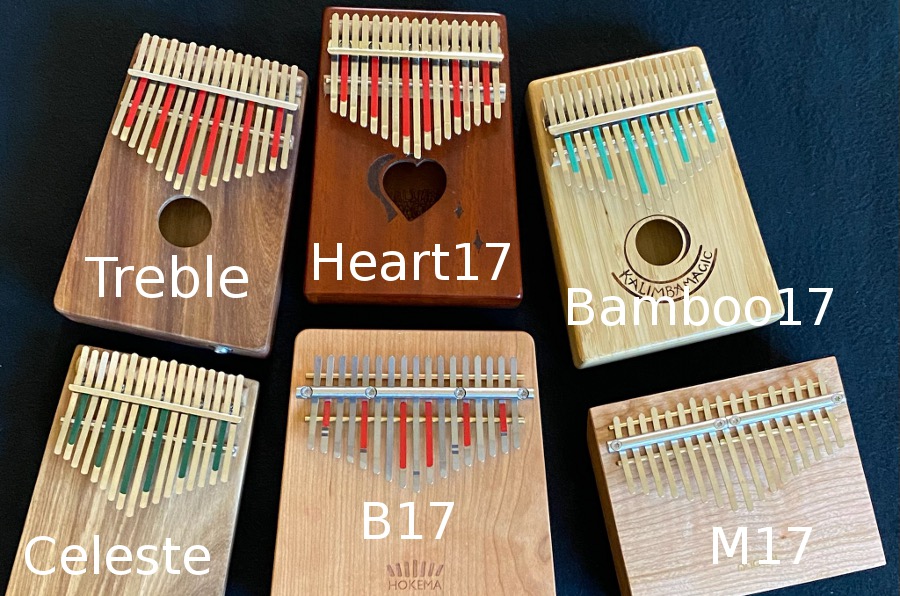
Hugh Tracey Treble (tuned to C), Hugh Tracey Celeste Treble (in C), the Heart-17 and Bamboo-17 kalimbas, the Hokema B17, and the Magadi M17. In my mind, they are all good instruments.
The Hugh Tracey Treble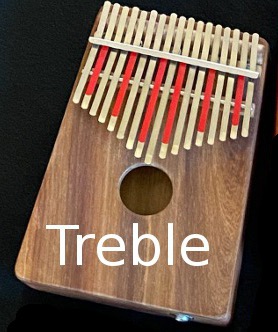 , made in South Africa, has a special place in my heart, because I spent so many years playing it. I think it has the best “wah wah” response, a good sound and a great feel when you play it. Note that the Treble kalimba usually comes in the key of G, so if you want it this way you will need to select the “C Tuning”. Excellent durability, this kalimba should last your entire life if you treat it well. Made from African kiaat wood, the Treble kalimba is 5″ wide at the foot, 4.125″ wide at the head, and just over 7″ from head to toe. About 10-11 oz, the African kiaat wood has a variable density. The sap wood is blond in color and is much less dense.
, made in South Africa, has a special place in my heart, because I spent so many years playing it. I think it has the best “wah wah” response, a good sound and a great feel when you play it. Note that the Treble kalimba usually comes in the key of G, so if you want it this way you will need to select the “C Tuning”. Excellent durability, this kalimba should last your entire life if you treat it well. Made from African kiaat wood, the Treble kalimba is 5″ wide at the foot, 4.125″ wide at the head, and just over 7″ from head to toe. About 10-11 oz, the African kiaat wood has a variable density. The sap wood is blond in color and is much less dense.
By the way, these little sound bites are excerpts from the full video, an extensive comparison among our 17-note Kalimbas in C.
Hugh Tracey Treble Kalimba
The Heart-17 is actually the loudest kalimba we have in this comparison. It has a good clear sound. It is a handsome kalimba, and I am partial to the heart shaped sound hole. Made of stained mahogany, this is the same size as the Hugh Tracey Treble Kalimba. Weight 10 oz.
Heart-17 Kalimba
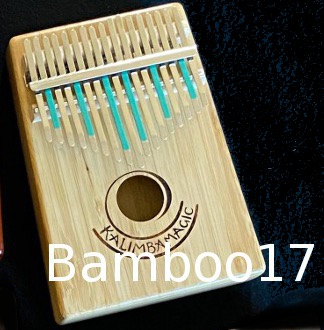 The bargain kalimbas are the Heart-17, Bamboo-17, and M17 kalimbas. These are made in China and cost less than the other kalimbas, but they sound remarkably good considering their price point. The one that keeps following me around on my walks is the Bamboo-17. In fact, over the last four months, this is the instrument that I cannot put down. It is one of the cheapest kalimbas we sell, and yet it is the one that I end up playing about half the time! It has a brighter tone, and has less sustain… which for me is a good thing. Why?
The bargain kalimbas are the Heart-17, Bamboo-17, and M17 kalimbas. These are made in China and cost less than the other kalimbas, but they sound remarkably good considering their price point. The one that keeps following me around on my walks is the Bamboo-17. In fact, over the last four months, this is the instrument that I cannot put down. It is one of the cheapest kalimbas we sell, and yet it is the one that I end up playing about half the time! It has a brighter tone, and has less sustain… which for me is a good thing. Why?
Technical digression on sustain, do you want it, and why I like this lower sustain kalimba so much: You have little control over how long a note will last on a kalimba. You pluck it, and it dies out over a time between 1 second and 10 seconds, depending on the stiffness of the kalimba. The B17 has a sustain more like 10 seconds, and the Bamboo-17 has as sustain time more like 2 seconds. If you are playing slow meditative music with a note every few seconds, you will likely prefer the B17 kalimba. However, if you are like me, and you are playing several notes every second, a long sustain will tend to muddy the harmonies. For that reason, I really like the shorter sustain on the bright Bamboo-17. The notes get out of the way in time for the next notes to come on line. Made of bamboo wood. Same size as the Treble kalimba, weight 11 oz.
Bamboo-17 Kalimba
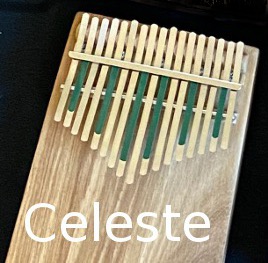 The Hugh Tracey Celeste Treble is also a very fine instrument. It is mounted on a solid piece of wood, without a sound hole or resonant chamber. It is not as loud as the Treble mounted on a box, but it has a “flatter EQ curve”. The box models have a peak in the midrange due to the resonance of the air in the box. Without that resonance, the celeste has a more even response from low notes to high notes. It has a nice clear, even sound. Note that the Treble kalimba usually comes in the key of G, so if you want it this way you will need to select the “C Tuning”. The footprint is the same as the Treble Kalimba, but the wood is not as deep – tapering from 0.75″ at the head to about 0.4″ at the foot. Weight 9 oz.
The Hugh Tracey Celeste Treble is also a very fine instrument. It is mounted on a solid piece of wood, without a sound hole or resonant chamber. It is not as loud as the Treble mounted on a box, but it has a “flatter EQ curve”. The box models have a peak in the midrange due to the resonance of the air in the box. Without that resonance, the celeste has a more even response from low notes to high notes. It has a nice clear, even sound. Note that the Treble kalimba usually comes in the key of G, so if you want it this way you will need to select the “C Tuning”. The footprint is the same as the Treble Kalimba, but the wood is not as deep – tapering from 0.75″ at the head to about 0.4″ at the foot. Weight 9 oz.
Hugh Tracey Celeste Treble Kalimba
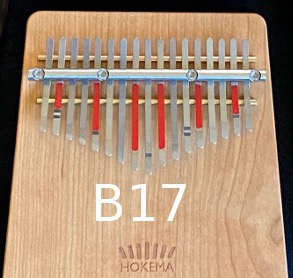 I think that the Hokema B17 Kalimba may be the finest kalimba of the 17-Notes that I sell. It is easy to play because of the precision-engineered tines and the extra space between them. The clarity of sound, in my mind, is tops. Even on the highest notes. It also has the best sustain, and notes can last up to 10 seconds. The enhanced sustain is due, in large part, to the massive wood body. I find the kalimba is too heavy for my kalimba walks. Body tapers from 6.75″ wide to 5.75″ wide at the head, 7″ from head to toe, and a full 1″ depth. Weight 19.5 oz.
I think that the Hokema B17 Kalimba may be the finest kalimba of the 17-Notes that I sell. It is easy to play because of the precision-engineered tines and the extra space between them. The clarity of sound, in my mind, is tops. Even on the highest notes. It also has the best sustain, and notes can last up to 10 seconds. The enhanced sustain is due, in large part, to the massive wood body. I find the kalimba is too heavy for my kalimba walks. Body tapers from 6.75″ wide to 5.75″ wide at the head, 7″ from head to toe, and a full 1″ depth. Weight 19.5 oz.
Hokema B17
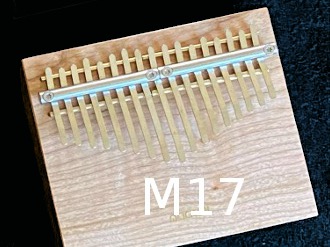 I find the Magadi M17 kalimba plays very well, and perhaps sounds the most like a diminutive music box. Charming. 6.25″ wide by 5.25″ tall by 1.25″ deep. Weights 17 oz.
I find the Magadi M17 kalimba plays very well, and perhaps sounds the most like a diminutive music box. Charming. 6.25″ wide by 5.25″ tall by 1.25″ deep. Weights 17 oz.
Magadi M17 Kalimba
Six 17-Note Kalimbas play in side by side comparison.
About the tine painting: due to a joke of recent history – I don’t know if it was on purpose or by accident – there are two standards on how to color the tines on these 17-Note kalimbas. The way I have been doing it for over 10 years on these types of kalimbas, and building on almost 70 years of Hugh Tracey’s system, I paint six tines.
Getting the tines painted in this system opens you open to my entire library of instructional materials for the 17-Note Kalimba in C. If you want your 17-Note kalimba painted in the 5-tine method, you can ask and we will give it to you that way.
If you don’t know what you want, you can also get your kalimba tines unpainted. You can color them temporarily with nail polish, Sharpie marker, or decals.
When you buy a 17-Note Kalimba in C from Kalimba Magic, we include our booklet, “Intro to the 17-Note Kalimba in C”… which has tablature with six painted tines.


Sign up for our newsletter and free resources with your email address:
We pinky promise not to spam you and to only send good stuff.
 Christmas in July 2025
Christmas in July 2025 Patriotic and American Music for Kalimba
Patriotic and American Music for Kalimba